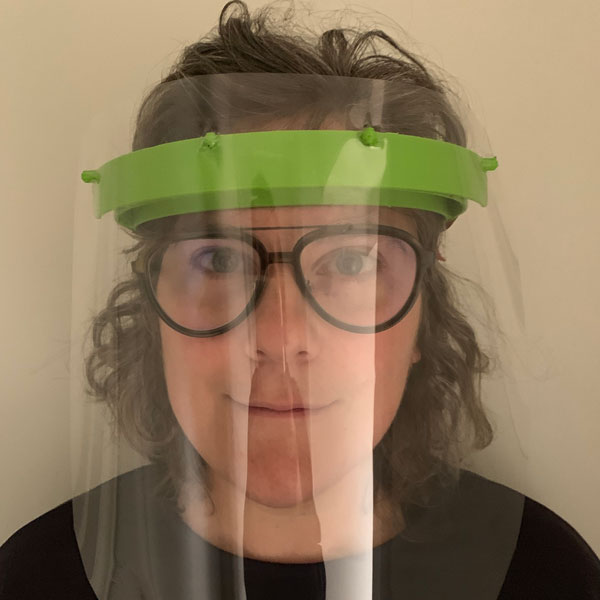As a response to the ever-increasing needs and shortages experienced by medical care providers dealing with the Coronavirus pandemic, a group of Colorado College faculty and staff are working together to produce 3D printed face shields.
The face shields will help alleviate the personal protection equipment (PPE) shortage experienced by medical professionals both locally and nationally. The effort, using the college's 3D printers and lasers, is a collaboration between faculty in the departments of mathematics and computer science, art, and psychology, members of the ITS staff, and volunteers from the Air Force and like-minded Colorado Springs residents who are combining their talents and resources to help those in hospitals and other emergency management services.
The collaborators have partnered with the Pikes Peak Regional Office of Emergency Management Team to understand the exact and growing needs of the local healthcare service teams.
CC Associate Professor of Mathematics and Computer Science Andrea Bruder and Assistant Professor of Art Rachel Paupeck had each embarked on the identical project without realizing it.
Bruder, a mathematician whose fields are differential equations and applied mathematics, started researching 3D printed personal protective equipment (PPE) after hearing about the increasing shortages across the country. Her research eventually led her to a face shield based on a Swedish design that had been approved by a physician at the Weill Cornell Medical Center.
When a friend with a 3D printer printed a prototype for her, Bruder knew it was possible - and began reaching out to others for help with researching materials, developing large-scale printing capacity, and connecting with hospitals to learn what kind of PPE they could accept.
Along the way, Bruder connected with Dez Menendez, director of Creativity & Innovation at CC, who put her in touch with Assistant Professor of Art Rachel Paupeck, who also had started working on the problem.
"I was going crazy wanting to help; I wanted to do what I could I do to help solve this," says Paupeck, who left New York City to begin teaching integrative design and architecture at CC last fall.
"I often tell my students that design is a form of problem solving - and now here was a problem and I knew I had both the tools and technical resources to make a difference," says Paupeck, a Rhode Island School of Design graduate. "I found some fellow RISD alums who were doing the same thing, and I started talking to them about how they have transitioned their studio to help. I have loved this moment where all designers are remembering their roots which are based in deep collaboration and all sense of propriety or territory has been put aside for the greater good - and I hope we can maintain this spirit in the future.
Paupeck went to work making prototypes of the face shield using the two 3D printers in the Art Department. She is making single-use shields as well as reusable shields, which are more sustainable but require a different type of plastic. The reusable shields are made of PETG plastic - a similar material as in plastic water bottles, which can be sanitized.
The face shields are comprised of two parts, a clear visor that wraps 180 degrees around the user's head, and an elastic headband that holds it in place. The team plans to make hundreds of reusable and single-use face shields over the next few weeks, with shields that are durable, flexible enough to be comfortable for extended periods of time, and fog-resistant, and fit over goggles and masks.
"We want to hear from local healthcare professionals to make sure that we are producing PPE that meets their needs and they are able to use. Currently, we are able to print the Prusa model and the Swedish design. We are looking to scale our production capacity, and we would like to collaborate with others in Colorado who have 3D printing capabilities," says Bruder.
Paupeck says it currently takes about three hours to produce one shield, but she is aiming to get production time down to 15 minutes through iterating the design and adjusting printing variables. The design calls for PETG (non-carbon) filament plastic; she uses 2.88 millimeter spool plastic for the headgear and .03 millimeter sheet plastic for the shield. Cost per face shield is less than $5, says Bruder.
While Bruder and Paupeck have taken the lead in the effort to produce face shields via 3D printing, many others at CC have made vital contributions to the project. Associate Professor of Psychology and Chair of the CC COVID-19 Task Force Emily Chan helped connect them with the Pikes Peak Regional Office of Emergency Management Team. Creativity & Innovation at CC has put additional laser cutters at their disposal -and the assistance of the program's paraprofessional SethWilson Gray '19. Weston Taylor, Chad Schonewill, and Devon Sherwood in ITS are helping to get the 3D printers at Tutt Library online.
"It has been an enormous collaborative effort," says Bruder. "I love how both design and mathematics can be thought of as forms of problem-solving."
Adds Paupeck, "We are grateful to be part of such a caring, hopeful and committed community."
Bruder and Paupeck say there are several ways to help:
- Donate here
- Volunteers can help regardless of whether they have a 3D printer. Resources include:
- 3D printed face shield: https://www.prusaprinters.org/prints/25857-prusa-protective-face-shield-rc2
- Fabric face masks: https://www.deaconess.com/How-to-make-a-Face-Mask



